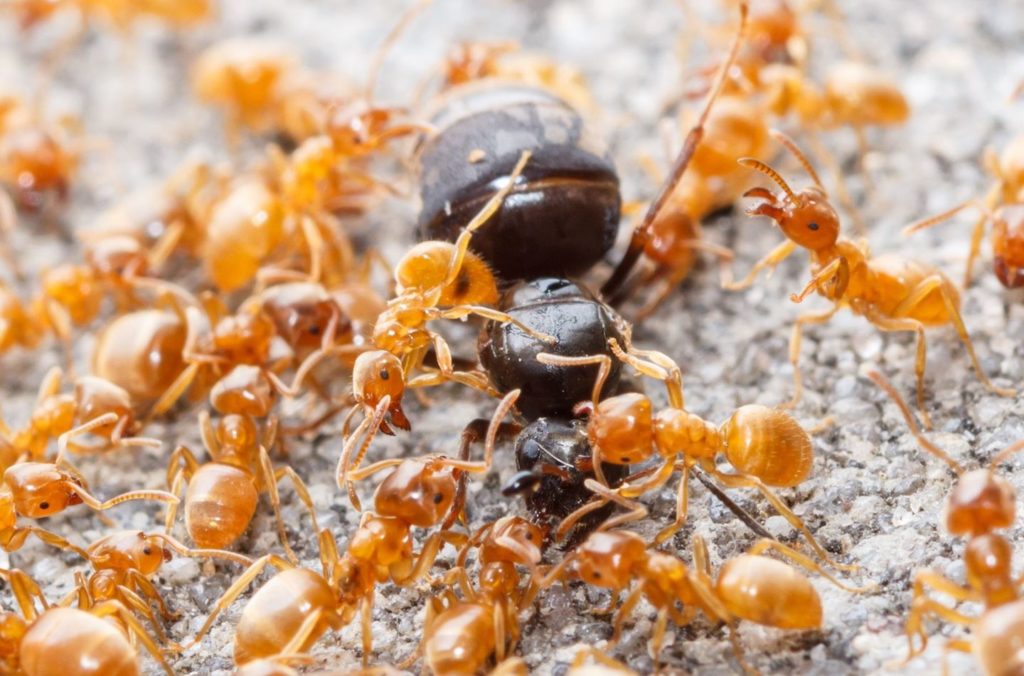Carpenter ants ‘throw up’ on each other to say hello
Hormones transmitted in ant vomit contain messages and influence the growth of baby ants, a study has found
When ants ‘talk’ by exchanging liquid mouth-to-mouth, they’re not just communicating vital information about the colony, they’re also passing on hormones that influence how the lucky recipients of their vomit will grow and develop.
As well as communicating via pheromones, sound and touch, ants talk to each other by exchanging liquid mouth-to-mouth in a process called trophallaxis. This isn’t quite as sweet as ants kissing, sadly, it’s more like ants throwing up in each other’s mouths to say hello after they’ve been exploring the world outside their nest.
Ants actually have two stomachs, with the second one set aside for storing food to be shared with other ants. They’re not the only animal to engage in this unceremonious fluid exchange either, as gray wolves, vampire bats and multiple bird species all share their appreciation of each by throwing up in the mouths of loved ones. What makes ants different, however, is that only they (and certain bee species) use trophallaxis for communication as well as food exchange.
Researchers at the University of Lausanne, Switzerland, studied a group of Florida carpenter ants to determine how the exchange of proteins, hormones and small molecules during trophallaxis is used to communicate information between individuals. The researchers observed that trophallaxis not only occurred when ants had food to share, but on other occasions too, such as when starved worker ants returned to the colony after a period of isolation, or when ants are acting aggressively or attempting to appease each other.
By analysing the trophallactic fluid exchanged between ants, the researchers concluded that trophallaxis is used to regulate the development and growth of ant larvae. Researchers collected tiny amounts of the fluid (about 0.34 millionths of a litre per sample) from the mouths of reuniting ants after time away from the colony by squeezing the abdomens of anaesthetised ants until they released the liquid.
Nanoscale liquid chromatography and tandem mass spectrometry analyses revealed that the trophallactic fluid released by the ants contains hydrocarbons, microRNA, and juvenile hormones that regulate the development of ant larvae. When the worker ants’ food was supplemented with juvenile hormones, the researchers found that the larvae being fed via trophallaxis by the hormone-supplemented worker ants were twice as likely to complete metamorphosis and become larger workers. At least ten proteins found in the trophallactic fluid are thought to be involved in the development of ant larvae.
Ant larvae may go down several developments paths depending on the hormones and the amount of food they are exposed to while they are growing. Most become worker ants, but some particularly well-fed females will become winged ‘princess ants’ that then fly away from the colony to become the queen ant at another colony. The study also hypothesises that in other species the presence of specific hormones in the trophallactic fluid may make it more likely that ant larvae would grow into a queen ant rather than a worker ant. Queens ants have some of the longest life expectancies of any insect on Earth with the queens of some species living up to 30 years in ideal conditions.
“These findings suggest that trophallaxis underlies a private communication mechanism that can have multiple [physical] consequences,” the study concludes.

